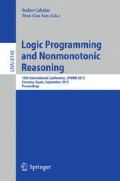Abstract
Answer set programming (ASP) is nowadays one of the most popular modeling languages in the areas of Knowledge Representation and Artificial Intelligence. Hereby one represents the problem at hand in such a way that each model of the ASP program corresponds to one solution of the original problem. In recent years, several tools which support the user in developing ASP applications have been introduced. However, explicit treatment of one of the main aspects of ASP, multiple solutions, has received less attention within these tools. In this work, we present a novel system to visualize relations between answer sets of a given program. The core idea of the system is that the user specifies the concept of a relation by an ASP program itself. This yields a highly flexible system that suggests potential applications beyond development environments, e.g., applications in the field of abduction, which we will discuss in a case study.
Supported by the Austrian Science Fund (FWF) under grant P25607, and by the Vienna University of Technology special fund “Innovative Projekte” (9006.09/008).
Access this chapter
Tax calculation will be finalised at checkout
Purchases are for personal use only
Preview
Unable to display preview. Download preview PDF.
References
Brewka, G., Eiter, T., Truszczyński, M.: Answer set programming at a glance. Commun. ACM 54(12), 92–103 (2011)
Charwat, G., Wallner, J.P., Woltran, S.: Utilizing ASP for generating and visualizing argumentation frameworks. In: ASPOCP 2012, pp. 51–65 (2012)
Cliffe, O., De Vos, M., Brain, M., Padget, J.: ASPVIZ: Declarative visualisation and animation using answer set programming. In: Garcia de la Banda, M., Pontelli, E. (eds.) ICLP 2008. LNCS, vol. 5366, pp. 724–728. Springer, Heidelberg (2008)
Eiter, T., Gottlob, G.: The complexity of logic-based abduction. J. ACM 42(1), 3–42 (1995)
Febbraro, O., Reale, K., Ricca, F.: ASPIDE: Integrated development environment for answer set programming. In: Delgrande, J.P., Faber, W. (eds.) LPNMR 2011. LNCS, vol. 6645, pp. 317–330. Springer, Heidelberg (2011)
Fruchterman, T.M.J., Reingold, E.M.: Graph drawing by force-directed placement. Softw., Pract. Exper. 21(11), 1129–1164 (1991)
Gebser, M., Kaminski, R., Kaufmann, B., Ostrowski, M., Schaub, T., Schneider, M.: Potassco: The Potsdam answer set solving collection. AI Commun. 24(2), 105–124 (2011)
Hendler, J.A., Tate, A., Drummond, M.: AI planning: Systems and techniques. AI Magazine 11(2), 61–77 (1990)
Kamada, T., Kawai, S.: An algorithm for drawing general undirected graphs. Inf. Process. Lett. 31(1), 7–15 (1989)
Katsuno, H., Mendelzon, A.O.: Propositional knowledge base revision and minimal change. Artif. Intell. 52(3), 263–294 (1991)
Kloimüllner, C., Oetsch, J., Pührer, J., Tompits, H.: Kara: A system for visualising and visual editing of interpretations for answer-set programs. In: WLP 2011 (2011)
Leone, N., Pfeifer, G., Faber, W., Eiter, T., Gottlob, G., Perri, S., Scarcello, F.: The DLV system for knowledge representation and reasoning. ACM Trans. Comput. Log. 7(3), 499–562 (2006)
Oetsch, J., Pührer, J., Tompits, H.: The SeaLion has landed: An IDE for answer-set programming – Preliminary report. In: WLP 2011 (2011)
Author information
Authors and Affiliations
Editor information
Editors and Affiliations
Rights and permissions
Copyright information
© 2013 Springer-Verlag Berlin Heidelberg
About this paper
Cite this paper
Ambroz, T., Charwat, G., Jusits, A., Wallner, J.P., Woltran, S. (2013). ARVis: Visualizing Relations between Answer Sets. In: Cabalar, P., Son, T.C. (eds) Logic Programming and Nonmonotonic Reasoning. LPNMR 2013. Lecture Notes in Computer Science(), vol 8148. Springer, Berlin, Heidelberg. https://doi.org/10.1007/978-3-642-40564-8_8
Download citation
DOI: https://doi.org/10.1007/978-3-642-40564-8_8
Publisher Name: Springer, Berlin, Heidelberg
Print ISBN: 978-3-642-40563-1
Online ISBN: 978-3-642-40564-8
eBook Packages: Computer ScienceComputer Science (R0)

